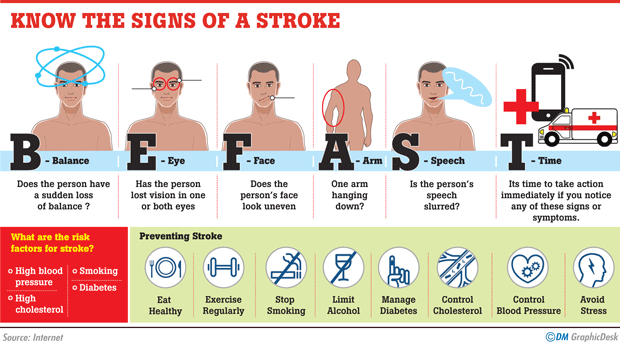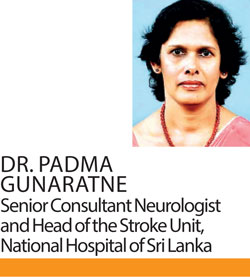Reply To:
Name - Reply Comment

 Out of the population of 21 million in the country, there are 200,000 who have survived strokes. Strokes are a serious threat to the quality of health and a severe medical malady. As world Stroke Day is around the corner (October 29), Health Capsule interviewed Dr. Padma Gunaratne, Senior Consultant Neurologist and Head of the Stroke Unit, National Hospital of Sri Lanka, to raise awareness on strokes and to minimize the number of deaths due to this ailment. Providing insightful knowledge on strokes, she accentuated that strokes are preventable. It’s all a matter of being aware which would contribute towards a healthier nation.
Out of the population of 21 million in the country, there are 200,000 who have survived strokes. Strokes are a serious threat to the quality of health and a severe medical malady. As world Stroke Day is around the corner (October 29), Health Capsule interviewed Dr. Padma Gunaratne, Senior Consultant Neurologist and Head of the Stroke Unit, National Hospital of Sri Lanka, to raise awareness on strokes and to minimize the number of deaths due to this ailment. Providing insightful knowledge on strokes, she accentuated that strokes are preventable. It’s all a matter of being aware which would contribute towards a healthier nation.
Definition
A stroke occurs secondary due to problems in the blood vessels supplying the brain. “Every tissue in our body requires proper blood supply to function. The blood supply consists of oxygen, glucose and other nutrients. The structure of the brain is such that every cell has a functional significance. Different areas of the brain are specialized for different functions. There are three (3) main blood vessels that provide blood supply to the brain. These arteries branch further into arterioles and capillaries ensuring that each cell of the brain receives an adequate blood supply. When the blood supply to a particular part of the brain is disturbed (either by a block or rupture of the blood vessel), the cells deprived of the blood supply become dysfunctional. The consequence of this would lead to a stroke. Symptoms are determined based on the specified function of the affected part of the brain” explained Dr. Gunaratne.
Risk groups
According to Dr. Gunaratne, research studies in Sri Lanka have indicated that 10 in every 1000 people suffer strokes. “The Sri Lanka Stroke Clinical Registry states that all major hospitals in the island receive more than 1000 stroke patients per year. The prevalence of a stroke increases with age. But in Sri Lanka, 33% of stroke patients are under age 60 and in their productive years. 7% of strokes are young strokes, which prevail in people under age 45. Generally males suffer strokes more than females, but after 50 years, the prevalence of a stroke becomes equal. According to the Stroke Clinical Registry, 57% of males are stroke patients,” the doctor said.
Causes 
The main reason for strokes is the thickening of the blood vessels, also known as atherosclerosis. There are many factors that contribute towards this condition. “Some causes are reversible while others are not. Non- reversible factors such as ageing and genetics are beyond our control. So we should focus more on reversible factors that lead to strokes. There are 4 main risk factors that could lead to a stroke. They are lack of exercises, an unhealthy diet, alcohol and smoking,” she warned.
These risk factors lead to obesity and also to conditions such as high blood pressure, high blood sugar and high cholesterol. People who have any of these conditions bear the risk of a stroke. Heart attacks and heart diseases also hold the high probability of strokes.
Symptoms
Dr. Gunaratne stressed that it’s of utmost importance to have proper knowledge with regard to the symptoms of strokes, so that a person can take immediate and appropriate action. “A stroke is a brain attack. There are signs that warn of a stroke. Suddenly developed paralysis of the face, arm or leg is common. Speech would also be affected by strokes. The ability to express oneself and the ability to understand could be affected. These factors should raise strong suspicions of a stroke, which demand immediate action. Some may face numbness in half of the body, some may find difficulties in walking and retaining balance while some may experience it hard to maintain proper vision. The vision in one eye could be affected or only half of an object might be visible. Severe headaches, sudden loss of consciousness and not regaining consciousness are also symptoms of stroke,” said Dr. Gunaratne.
Complications
A stroke can leave a patient with disabilities. These include physical disabilities, where the mobility of a patient is affected adversely (inability to walk, move arms) owing to paralysis. Difficulties in communication also arise. Swallowing problems, losing control of the bladder and problems in vision are effects of a stroke. “In addition, other problems such as depression, family issues and sexual problems, pain in limbs, social issues and economical issues may arise as long-term consequences,” added Dr. Gunaratne.
Seeking medical help
It’s strongly advised to seek medical attention at the slightest sign of any one of the symptoms mentioned above. Time is vital which is why knowledge of stroke symptoms is essential. “Symptoms appear even 5 minute after there’s a blockage in a blood vessel. Some brain cells may die immediately. Most brain cells may be affected, but are still viable and contribute towards the symptoms experienced for a few hours. If the block is treated immediately, these cells could be revived. The time limit within which these cells can be revived lasts for only 4.5 hours after a blockage, so immediate treatment is required. Treatment should be sought from a major hospital that has appropriate facilities for treatment such as a CT scanner. Action should be taken immediately when experiencing symptoms,” she accentuated.
Diagnosis and treatment
When a person seeks medical treatment on the suspicion that it could be symptoms of a stroke, a CT scan is ordered. The CT scan helps exclude patients with burst blood vessel before the clot buster treatment is administered. “Clot buster is an injection given to remove the blood clot by dissolving it. This injection is given within 4.5 hours from the time symptoms are experienced. This helps improve the outcome of the patient.
Some patients are paralyzed and are unable to swallow. If these patients are given food stuff to swallow, they develop complications such as aspiration pneumonia. Therefore they are tube fed until they are able to swallow on their own.
Paralyzed patients have to be turned constantly in order to prevent bed sores. The patient may suffer from other inconveniences such as soiling clothes, etc. “So much nursing has to be done while the patient recovers. If the proper care isn’t given the patient could die,” the doctor warned.
After the initial emergency care, during which the clot is dissolved and removed, the patient is cared for in the stroke unit by a team known as the multi disciplinary team. The team consists of a doctor, nurse, physiotherapist, occupational therapist, speech therapist, counsellor and social service officer. Together they nurse the patient back to normalcy. But according to Dr. Gunaratne this facility isn’t freely available in the country though and is a matter that should be looked into.
Prevention
Heart attacks and strokes share the same preventive measures. The probability of the thickening of blood vessels increases with age and with certain lifestyle factors. Therefore lifestyle modifications are necessary. Prevention can be taken with regard to the modifiable risk factors. This reduces the stroke risk by 90%. “Adhering to a healthy diet, moderate exercise, avoiding smoking, limiting alcohol, monitoring one’s blood pressure and controlling it are some measures. Controlling cholesterol, diabetes and weight is essential. Being aware of the stroke symptoms and taking action immediately, even if symptoms settle, minimize the adverse effects of strokes. If one suffers from heart diseases appropriate medication should be taken to avoid strokes. Patients who have recovered from strokes should continue with their medication to reduce the risk of another attack,” advised Dr. Gunaratne.